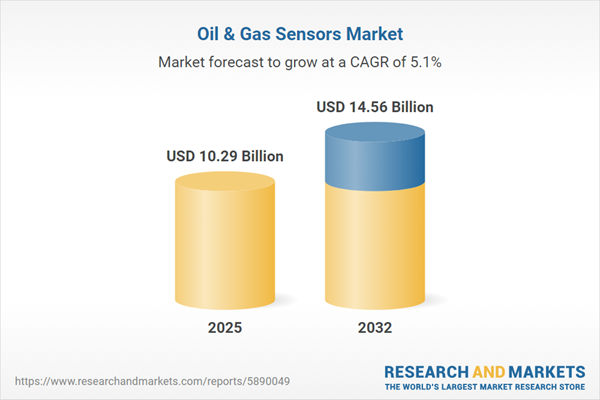Speak directly to the analyst to clarify any post sales queries you may have.
Sensor innovation is redefining how senior leaders in the oil and gas sector manage assets, compliance, and digital transformation. As sensor technology becomes a pivotal element in operational modernization, decision-makers are investing in integrated solutions that improve efficiency, risk management, and regulatory outcomes.
Market Snapshot: Oil & Gas Sensors Market Growth
The oil and gas sensors market is expected to grow from USD 9.79 billion in 2024 to USD 10.29 billion by 2025, and is further projected to reach USD 14.56 billion by 2032. This growth represents a compound annual growth rate of 5.09%. The surge is propelled by digitalization initiatives throughout upstream, midstream, and downstream operations, intensifying demand for reliable, adaptable sensor solutions. C-level leaders are focusing efforts on integrating advanced sensor technologies to drive actionable analytics, improve oversight, and modernize critical infrastructure for streamlined facility performance.
Scope & Segmentation of the Oil & Gas Sensors Market
This comprehensive report explores the global landscape of oil and gas sensors, detailing how advancing technology and evolving supplier tactics directly support strategic objectives and capital allocation for enterprises. Segmentation highlights how firms tailor operational approaches to shifting technology trends, procurement models, and market expectations across key geographies.
- Sensor Types: The market features flow measurement systems, gas detectors, vibration monitors, pressure sensors, temperature sensors, and level monitoring technologies. Each enables automation reliability, process safety, and regulatory compliance in diverse settings.
- Applications: Sensors are deployed across exploration, production, downstream processing, refinery operations, transport safety, and real-time process monitoring to drive productivity and enhance risk oversight along the value chain.
- End Users: LNG terminals, pipeline operators, refineries, petrochemical companies, and asset management teams utilize sensors for predictive maintenance, advanced process control, and preventative environmental monitoring.
- Installation Modalities: Deployment involves wired solutions such as Modbus and Profibus for complex communications, with wireless options like Bluetooth or Wi-Fi offering flexible, scalable setups and smooth integration with legacy systems.
- Regions Covered: The Americas, Europe, Middle East & Africa, and Asia-Pacific display varied regulatory landscapes, modernization roadmaps, and procurement practices that influence sensor implementation across facilities.
- Key Companies: Major players including Honeywell, Emerson, Siemens, ABB, Schneider Electric, General Electric, Yokogawa, Endress+Hauser, Rockwell Automation, and VEGA Grieshaber drive market differentiation through integrated sensor platforms and adaptive deployment strategies.
Key Takeaways: Strategic Insights for Oil and Gas Sensors Adoption
- Smart sensors underpin predictive maintenance, reinforcing system reliability and tailored risk response across complex facility environments.
- Integrating Industrial Internet of Things (IIoT) and analytics platforms generates actionable insights, optimizing real-time operations and supporting agile management decisions.
- Robust data integrity and cybersecurity protocols are necessary for dependable process controls and safeguarding sensor networks.
- Sustainability factors are now integral to procurement, ensuring alignment with environmental and regulatory benchmarks across international markets.
- Scalable sensor infrastructures allow companies to minimize operational interruptions and adjust seamlessly to changing compliance or technology needs.
Tariff Impact and Supply Chain Resilience
Current tariff measures in major regions, such as the United States, present sourcing challenges for firms requiring MEMS devices and specialized sensor parts. Companies are responding by diversifying suppliers, implementing nearshoring where appropriate, and reinforcing supply chain partnerships. These strategic steps help organizations safeguard project schedules and ensure sustained access to high-performance sensor innovations during shifts in global trade policies.
Methodology & Data Sources
This analysis draws on leadership interviews, sensor technology workshops, and patent review processes. Findings are substantiated with regulatory analysis and cross-verified through multiple industry data streams, delivering relevant and actionable intelligence for executive teams.
Why This Report Matters for Oil & Gas Stakeholders
- Equips decision-makers with clear guidance on aligning technology agendas with modernization and compliance objectives, achieving optimized resource deployment.
- Clarifies sector-wide digital transformation trends and key supplier advancements, enhancing visibility and reliability in supply chain and operational planning.
- Provides frameworks for sustainable procurement and proactive risk management, supporting leaders in addressing regulatory pressures and dynamic market forces.
Conclusion
Leveraging advanced sensor solutions is fundamental to strengthening operational performance, compliance, and long-term resilience within the oil and gas industry.
Additional Product Information:
- Purchase of this report includes 1 year online access with quarterly updates.
- This report can be updated on request. Please contact our Customer Experience team using the Ask a Question widget on our website.
Table of Contents
3. Executive Summary
4. Market Overview
7. Cumulative Impact of Artificial Intelligence 2025
Companies Mentioned
The companies profiled in this Oil & Gas Sensors market report include:- Honeywell International Inc.
- Emerson Electric Co.
- Siemens AG
- ABB Ltd.
- Schneider Electric SE
- General Electric Company
- Yokogawa Electric Corporation
- Endress+Hauser AG
- Rockwell Automation, Inc.
- VEGA Grieshaber KG
Table Information
| Report Attribute | Details |
|---|---|
| No. of Pages | 196 |
| Published | October 2025 |
| Forecast Period | 2025 - 2032 |
| Estimated Market Value ( USD | $ 10.29 Billion |
| Forecasted Market Value ( USD | $ 14.56 Billion |
| Compound Annual Growth Rate | 5.0% |
| Regions Covered | Global |
| No. of Companies Mentioned | 11 |









